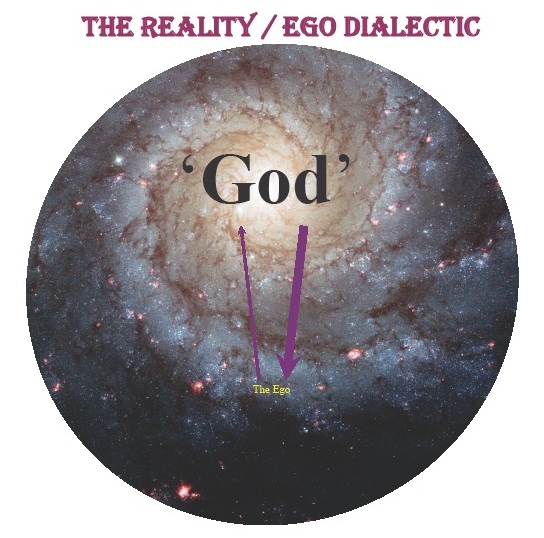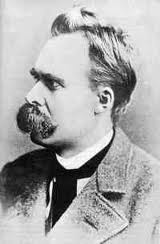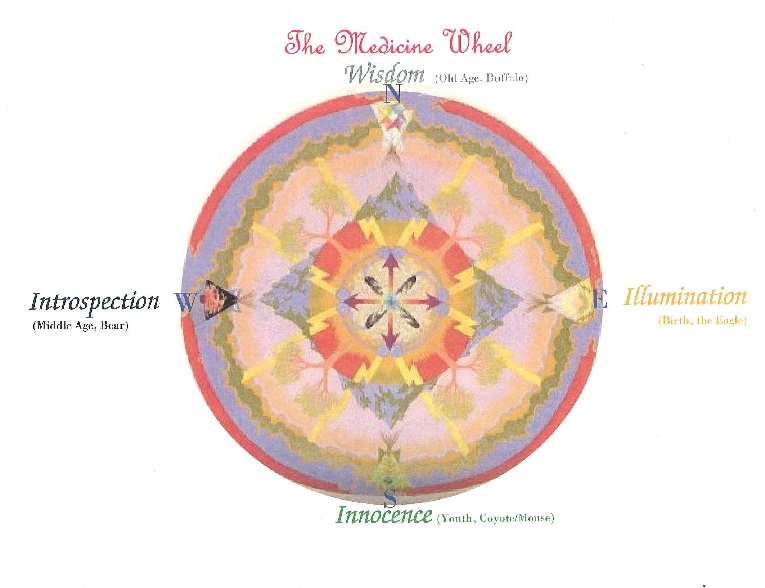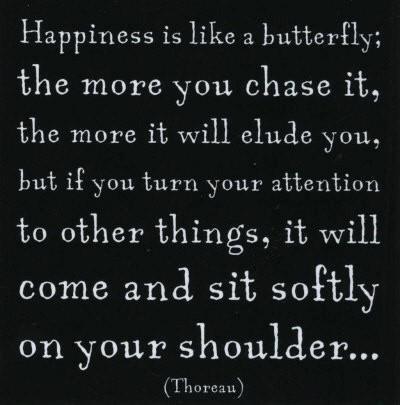 4. The Meaning(s) of Life
4. The Meaning(s) of Life
This page is still under construction, and at least two Videos are Pending . . .
If you seriously ask yourself, or virtually anyone you know, what the meaning of life is you will generally get some version of one of the four answers circling the Tao symbol above. It turns out that psychologically or spiritually (depending on your perspective) the four answers are related, and as such from an archtypical human perspective, perhaps one day the bulk of humanity may come to agreement that the four Meanings, taken together, can as a whole be called The Meaning of Life
For those who are in a hurry: Read on through to find Premise #3 in Red. It is about meaning #2 on the Tao circle above which, once its properly understood, is the game changer.
*
In the diagram above God is in quotes because, though it will seem strange to many, at least for practical social purposes God can be defined so broadly that the old theist / atheist debates don’t need to become problematic. For more on that debate resolving idea see, On Reverence.
~~~~~~~~~
Now, to understand how and why the four meanings at right are related, and are shown circling the Tao symbol with the four terms in cursive, one must:
a. Contemplate the nature of the human consciousness’s interaction with reality: Most of us naturally assume and feel that our consciousnesses are part of the wider reality, but it is the nature of consciousness that it mostly creates internal models of reality. The consciousness may be apart of reality, but it is not reality, as a whole, by itself. That would be solipsism, which for most is a belief so paradoxical that a very few seriously subscribe to it. Hence our ego’s, cognitively, are almost always somewhat conscious of a disquieting separateness.
And:
b. Understand the core dialectic of the human situation: the process of growing in consciousness from infancy to adulthood is in many ways a process of coming to know that our egos (our selves) are no more than tiny fragile ephemeral motes in the larger reality. As conscious beings, by definition, we can hardly help but associate our sense of self with what it means to be alive. Therefore, it is natural, and for humanity archtypical, that the ego craves deeper connection to something more transcendently real.
Most people are healthy and humble enough that, at least intellectually or logically, they see that the path to meaningful connection lies in revering the ‘transcendentally larger reality’ via various subjectively, or personally, appropriate paths such as: work, meditation, prayer, ritual, service, etc. etc. 
Alternatively some people try to deal with their individual ego’s fragile connection to the larger reality by insisting that the ego, or their ego, is actually something of truly significant power in itself. Two notable modern historical examples would be Nietzsche and Rand. But for such egotism to seem to work even on a narrowly focused human scale,
 Nietzsche had to glorify only the few human, ‘supermen’ whose egos could achieve a superficial sense of deeper stronger self contained reality via the’will to power.’ but, illogically (considering how small a thing humanity really is in cosmic space and time), the examples he gave of such supermen still needed the submission of other Homo sapiens in the larger reality.
Nietzsche had to glorify only the few human, ‘supermen’ whose egos could achieve a superficial sense of deeper stronger self contained reality via the’will to power.’ but, illogically (considering how small a thing humanity really is in cosmic space and time), the examples he gave of such supermen still needed the submission of other Homo sapiens in the larger reality.
 Rand tried to sidestep such human social and parochial awkwardness by having her egoist’s “most noble activity” be productive creativity, which still required the larger human and natural world to give the ego meaning, which was not logically ‘self’ contained. Yet her world view was still socially awkward because to feel the ego’s self sufficient power she still needed to glorify her idea of supermen ‘prime movers’ within human culture which denigrated to an irrational degree the collective values that increase human productivity via synergy.
Rand tried to sidestep such human social and parochial awkwardness by having her egoist’s “most noble activity” be productive creativity, which still required the larger human and natural world to give the ego meaning, which was not logically ‘self’ contained. Yet her world view was still socially awkward because to feel the ego’s self sufficient power she still needed to glorify her idea of supermen ‘prime movers’ within human culture which denigrated to an irrational degree the collective values that increase human productivity via synergy.
An instructive traditional way to understand the archetypal roots of the four Meanings of Life circling the Tao above is found by looking at the wisdom at the heart of North American Plains Indian spiritual traditions;
The Plains Indians call the diagram above the Medicine Wheel (see the classic book by Hyemeyohsts Storm), and it ties the common different perspectives of the Meaning of life together:
Talk about the medicine wheel: The vertical ‘connection’ dialectic of ego/God and innocence/wisdom. And the horizontal subjetive, spiritual-religious, intrpospection / objective, scientific, illumination dialectic. You do not know there is an afterlife, but you do know about the awesome nature of this life in this creation. And beware of the ego’s desire to not die; is it really a craving to love and be near God, that leads one to focus on the afterlife, or is it merely the egoic desire to avoid the responsibility of finding the faith in the beauty of this creation and taking responsibility for one’s life NOW, as opposed to (what may be) fantasizing for a better future? Our ego’s can trick us. A native American symbol, por totem, for the egoistic part of the medicine wheel is the Coyote (also known as the trickster). Contrarily, when we take responsibility and balance or egos the totem is the mouse, and the word is innocence.
However, it is to our detriment that for most of us (at least in contemporary western civilization), our egos tend to make us examine two of the answers more then the other two. 
* →
* →
* →
* →
So, if you take anything from this blog, please let it be a deeper consideration of the significance of the core objective survival / biological Meaning of Life.
For further elucidation of the diagram at right see The Rose Mandala.
Premise 1: The overwhelming bulk of humanity’s skewed valuing of the literal meaning of life (towards meanings #1,3, & 4 on the Tao circle above, and away from2) is almost certainly the central reason why our civilizations is teetering on the brink. Ironically, it is also a core reason why there is so much human unhappiness and discontent.
Premise 2: The heart of an objectively social / ethical system should be the understanding that it is fair to say that a large portion of ‘the meaning of life’ is the same as the definition, as in meaning #2.
Premis 3a: The definition of life – Life is generally any individuated, physical, metabolizing process which (it can be shown or inferred) has become organized around the ability to function creatively over time to prevent the eventual dissolution of its ‘kind,’(where ‘kind’ means itself, it’s reproduced descendants, or it’s related community).
Premise 3b: The definition of life according to the biologists who study it can be broken down as:
1. It has cell membranes (It is individuated from the non-living external environment) (And the ego is fine with this).
2. It makes ATP (It metabolizes energy: eats, breaths, excretes) (The ego is fine with this also).
3. It can evolve. (but it does not have to)(The ego is fine with this).
4. It senses and responds to it’s environment (The ego is fine with this).
5. It maintains its DNA (Reproduces and works, or functions, to ensure that one’s DNA survives beyond the death of our egos, as far into the future as possible) (Our human egos are generally not fine with this. Most people will not debate that they need to accept that they must eat, breath, and sense thier environment, but when they are told that, logically, maintaining thier DNA, as the rest of life does that is successful, into the distant furture is just as important as the other parts of the definition of life, so they/we should be just as interested in the future of our DNA as we are in breathing, then they balk. Since our egos will be long gone we as individuals generally don’t care much about the distant future of our genes. We want to disdainfully call this part of the definition of life a lowly animal desire, and say that we (our egos) are above this; hence the looming destruction of our civilization and eventually, naturally (HA!), our species. The reverential need to fully accept the gift of existence in this reality, and therefore accept and work to fulfill this part of the definition of life is the central core point of the philosophy laid out in this blog.
6. Life also acts autonomously(And the ego is fine with this), at least to an extent (think of cells within an organism, sperm, or worker bees) to preserve it’s self (Think about downloading your brain onto the Internet. You would surely still be ‘alive,’ but only 2 and 6 would hold. Why is ‘self’ preservation critical to the definition of life, and maybe to a theory of life, and what does that say about the big deal ‘m making about preserving the DNA?)
There is an interesting article in the Huffington Post regarding R. Dawkins response to E. O. Wilson’s ideas about group selection versus Kin selection, here.
Premise 4: It is the third and forth part of the definition that is not properly acknowledged and understood. Particularly the third. Show parabolic ‘graph.’
An article on how our genes form a rope through time here.
Why does the conscious maintenance of one’s DNA lead to the creation of the crucial missing ethical foundation for human civilization?
Because a. it is already the key implicit subconscious foundation, but making it conscious will clarify and strengthen how it should most reasonably be applied.
b. it signifies a kind of algorithm about the ‘percentages’ of how much of one’s time and effort should be applied to sustaining one’s self, how much to one’s immediate family, one’s extended family, one’s species, one’s closely related species, and to life as a whole.
c. Becuase it makes explicit the stark logical conscienceless of determining, ultimately, if one should compete as the primary foundational ethic for the survival of one’s genes over others (thus causing evolution of the species), or if one should focus on cooperatively ensuring the survival of one’s genes, merely as a share of the genes of one’s species.
d. Once humans understand c., and understand that other humans should and will understand c. then one realizes that for one’s own genes to survive at all then one has to opt for cooperation and species survival.
The statements above have profound consequences regarding how to proceed on many political and economic issues.
↑In many ways this entire blog is merely an explanation of why the above statements are true.↑
Premise 5: Arguments for non-earthly or non-biological technological or ‘spiritual’ meanings to life are almost always rooted in delusional egoism. This may feel harsh, but, sorry, it is almost certainly true.
Premise 6: In practise, a proper acknowledgment of the importance of maintaining one’s / humanity’s genes will lead to a gracefully sustainable civilization.
Premise 7: Focusing logically on the maintenance of one’s genes will lead to an understanding that the impulse towards ‘survival of the fittest’ is not as ethically important for us humans as cooperation.
Premise 8: Focusing on the maintenance of one’s genes will lead to an understanding that humanity must come to a democratic agreement on maintaining no more, or less, then the earth’s optimum human population.
Premise 9: Once an optimum population is achieved, and before that, focusing on the maintenance of one’s genes will lead to an understanding that having children should generally be like voting: It is an obligation that all responsible citizens should wish to, and have the right to, participate in. Democratically everyone should be allowed and encouraged to reproduce themselves, but it you reproduce more then yourselves it is like voting more then once: you are crowding the optimum population and infringing on other’s rights.
Premise 10: Surely, we are currently over the optimum population. Since the right to reproduce is as fundamental as the meaning of life the only way to humanely reduce the population is by the slow and natural attrition that would occur due to sterility, accidental and premature death, etc.
*
For a nice primer on the standard Meaning of Life discussion go here.
Aristotle, the common sense philosopher, said that the meaning of life is to pursue happiness. The Buddha probably would not have insisted on a ‘Meaning of Life,’ but he would have acknowledged that we are all on a spiritual path. Augustine (and Jesus) said the meaning of life is to love God. Modern science doesn’t really give us a Meaning of Life, but it does give us a definition. These diverse opinions may seem a little confusing or even discouraging. Fortunately however, in antiquity the plains Indians of North America developed a sophisticated ‘spiritual’ (or psychological for the secular) compass to sum up how our consciousness integrates or connects with the larger reality. They called it the Medicine Wheel (see the classic book by Hyemeyohsts Storm), and not coincidentally it ties the common different perspectives of the Meaning of life together:
The trick is to understand that as we go through life, hopefully becoming more conscious we circle around a spiral. Typically the Indians saw the spiral starting where the sun rises, in the east.
You will notice that when you ask people what they think the meaning of life is you will tend to get just four answers. This shows the wisdom of //Tlili, and after her the native American Plains Indians, because the four answers correspond to the four directions: Where illumination in the East is about understanding what is (survival). Innocence in the South is about going with the flow and accepting your part, being who you are (pursuing your own happiness).
Introspection is about finding how to integrate into the whole (pursuing your spiritual path). Wisdom is about becoming integrated (loving God). And back to what is.
Carol Cleland, the meaning of Life, the definition of life, and a ‘theory of life.’ Part 1 (edit, shorten, clarify, spell check)
Carol C. was my favorite philosophy professor when I was a student at the University of Colorado Boulder; she was an honest, earnist, not motivated by authoritarian power, actively intelligent rarity (sad to say). She is interested in astro biology, and in helping humanity be able to discover life elsewhere in the universe, beyond earth. As such she is concerned that by defining life, we humans will ‘pigion hole’ life such that something that is exotic elsewhere in the universe will go unrecognized as life. She thinks we should develope a ‘theory of life.’ To explain the difference between a theory and a definition she often invokes the example of medieval alchemists trying to define/ understand water before the development of an atomic thory of matter. They merely used what seemded to be water’s most important characteristic, which was that it was a solvent. And so they also labeled various acids, such as nitric and hydrocloric acid, as types of water. She points out that after the development of an atomic, and a molecular, theory of matter the definition of water as H2O was not so much an attibute of water , like liquid or solvent, it was more of a discovery; i. e. H2O is what water is. She thinks a similar process, of finding a theory of life like the theory of matter, is our best hope for understanding life. The current biological definition, given above, would seem limiting to her because it would not be able to include something like artificial robotic life, or an evolved silicone based life.
My response: the stumbling block she and other scientists are encountering here, regarding how to label and thus be able to searth for life, is rooted and the amoral analytical traditions of modern philosophy. I.e. it is thought that proper philosophcal thinking cannot make or incorporate normative statements bacuase they are subjective and therefore analytically meaningless, becuase they cannot be broken down into objective truths. But, regardless, there is an underlying unacknowledged ethos behind the drive to: search for life, respect life, and adequately be able to label life.
With the ethical component acknowledged defining, and creating a theory, of life becomes easy:
Life: must be present when and where there is a self contained system through which energy is metabolized, and where the system will act creativelly to defend it’s own / it’s decsendents ability to continue being self contained and metabolizing.
Why would this work as a definition, and also a theory? There are no counter (non living) examples that contradict this definition that I can think of, and as a thoery of finding or discovering new forms of life it satifies our, thus far problematic life definition debate driving, healthy egoic need to find life, and also to ‘respect’ life’s dignity by searching for it while not destroying it or ourselves in the process. . .
Part 2, what this has to do with the Meaning of Life discusion above: Of course the earthly biological definiotn on the main part of the blog page above works, but as a subset of the broader universal definition of life. The question is, ethicalal, if we are wantting to respect and life by the rules of reality, should we be more flexible, leading our lives, and be willing to live or experiment with living by the larger definiton. For instance(s), as a mandate, should we be O.K. with focusing less on living as earthly biological life and more on, post biological death, spiritual life, or with developing artificial intellegnce and downloading our brains into computers (and / or thus merging our consciousnesses on some future internet, or should we be focusing on developing eternal youth / anti aging medications?? . . . (to be continued)

Related Posts and Links:
